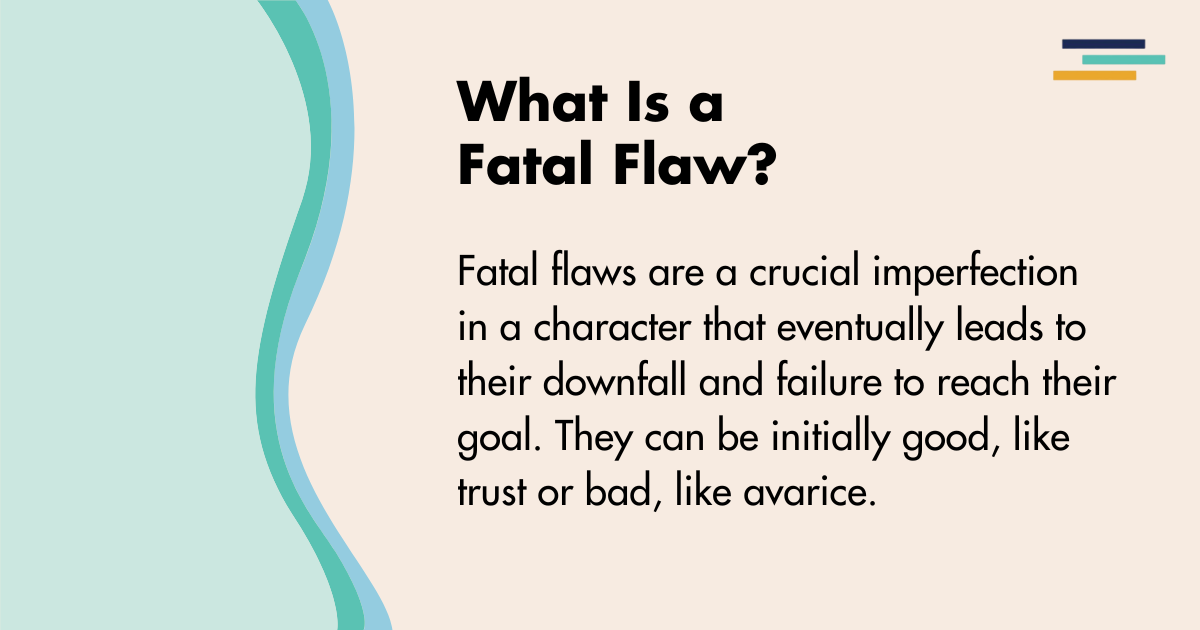
In fiction, a character’s fatal flaw is a personal trait or belief that will cause a character to fail at their goal. It is a critical imperfection in their makeup that leads to their downfall. Although fatal flaws are not necessarily fatal, they do contribute to failure or tragedy and thus are sometimes called tragic flaws.
What Is a Fatal Flaw?
In his poetics, the ancient Greek philosopher Aristotle discusses how stories are more effective if characters are relatable in terms of appearing human and fallible. Thus a good tragedy tells the story of a character with believable imperfections, rather than a “bullet-proof” hero who is invincible, or for that matter, a one-dimensional villain without any redeeming qualities.
The concept of a fatal flaw was closely aligned with the Greek term, “hamartia,” meaning “to err” or “to miss the mark.”

Fatal Flaw Meaning
Fatal flaws are a subset of all the character’s shortcomings. In fiction, a character without any imperfections seems unrealistic. When a character has some quirks, foibles, or weaknesses, those traits make that character more interesting for a reader. Readers cannot relate to a perfect character who never makes a mistake, never doubts their own words or actions, or always prevails in a conflict.
Characters without any kind of flaw will come across to the reader as predictable and boring.
Both a character’s strengths and their flaws should be shown in the context of the plot, but it is the fatal flaw that will bring about the character’s undoing, reveal the underlying defects that will thwart their success, and lead to tragedy or even death.
Not all fatal flaws are deficiencies in a character. Even an essentially “good” characteristic, such as loyalty or moral integrity, can bring about a character’s downfall if it is not beneficial in the setting. A virtuous person might lack compassion for others who struggle, or a kind-hearted person might lean toward pleasing people instead of offering what is truly needed.
In the same way, curiosity drives scientists and explorers to greater achievements, but it also led Pandora to unleash all the world’s evils. Deliberating thoughtfully on difficult choices is prudent, but taking the decision-making process too far will leave a hero frozen with paralysis.
Characters who are otherwise good in nature, but who have been wounded by mishaps and misfortunes in life, will tend to shield themselves emotionally. This is a perfectly understandable reaction, but this protective armor can block them from fulfillment, sabotaging their efforts to develop a healthy relationship with others. An emotional shield can drive a wedge between potential lovers just as surely as running away at the first sign of a budding romance.
The extremes of any trait tend to push a character into the fatal flaw range. Extremes tend to blind a character to potential conflicts on their path to success. If a character is too trusting, for example, that can be as detrimental as being overly suspicious of the motives of others. A selfless hero who puts everyone’s needs before their own may neglecting themselves and burn out before their goal is achieved.
Famous Fatal Flaw Characters
Greek tragedies
Starting with the original plays from which the concept of the fatal flaw began, the surviving tragedies from the ancient Greek playwrights display striking examples of characters with fatal flaws. Heroes of classic Greek tragedies reach positions of power and prestige, where they are much lauded for their bravery, fine judgment, wisdom, and passion for life, but then fall from their great heights when their deficiencies are exposed.
For example, in Aeschylus’s Agamemnon, the king of Mycenae is a tragic hero who brings about his own destruction by his actions. His arrogance as a ruler and warrior leads him to refuse to accept there will be repercussions from his callous decisions. The play is still read today as an example of the clash between human ambition in the face of the indifferent fates.
Shakespeare’s Tragedies
The great tragic plays of William Shakespeare also provide examples of fatal flaws. In King Lear, the king’s three daughters flatter their father with protestations of how much they love him, but the King cannot distinguish between the flowery speeches and the true emotions underneath.
Lear’s vanity results in him wandering unprotected in a violent storm, inconsolable and made insane by his grief.
Pride and Prejudice by Jane Austen
In this classic novel of the Regency era, Elizabeth Bennet is initially prejudiced against Mr. Darcy due to his pride and elitism. Because she is disposed to think the worst of him, she easily believes George Wickham’s defamation of Darcy’s character and intentions.
It takes much evidence of Darcy’s generosity and good works before Lizzy accepts his love as true.
Superhero Comic Books
The notion that heroes must have a flaw even carries through to comic book superheroes. Storylines and characterizations are typically simplistic in this genre, yet a nod is given to the notion of the characters having fatal flaws.
For example, in the DC Comics universe, Superman is brought low by kryptonite, a fictional substance from his home world, which causes him to lose his super powers. Once exposed, the Man of Steel is weakened, becoming too frail to fight crime as he usually does.
The made-up word “kryptonite” has taken on the meaning of something that exploits an inherent weakness in a person’s makeup. In other words, a kind of fatal flaw.
Harry Potter Book Series by J.K. Rowling
In this series, we have examples of some flaws that could be classified as positive traits, but they are carried out in an atmosphere where they are not beneficial. Loyal and self-sacrificing to the extreme, these attributes sometimes cause Harry to act recklessly, be easily goaded by taunts against his friends, and overly sentimental.
Remember how the sorting hat at first thought Harry was a better candidate for Slytherin than Gryffindor? Remember how Harry’s use of the less-effective, but relatively harmless, disarming spell instantly revealed his identity to the Death Eaters?
The Maid by Nita Prose
In this murder mystery novel, Molly’s quirky mindset and unusual powers of observation are the perfect assets for solving a crime that baffles the police. Yet even her friends, when faced with her unconventional behavior, were unsurprised when the police sought her as a possible suspect.
A Court of Thorns and Roses by Sarah J. Maas
Feyre grew up to become a tough-minded, no-nonsense hunter, determined to save her family from their reversal of fortune, but these very traits led her to reject the friendship and love offered by her faerie companions.
Refusing to acknowledge her inner emotions nearly condemns herself and the future of the realm to the evil queen’s machinations.

List of Fatal Flaws
Almost any characteristic can become a fatal flaw in a specified circumstance. Fatal flaws can be destructive or unpleasant attributes, such as avarice, cowardice, or an ill-tempered nature, or they can be typically good traits that do not serve the character well in their current situation.
Here is a short list of possible options for characters who are fatally flawed:
- Abrasive
- Bullying
- Cynical
- Dishonest
- Evil
- Frivolous
- Gullible
- Hypocritical
- Impatient
- Judgmental
- Lazy
- Manipulative
- Obsessive
- Paranoid
- Rude
- Selfish
- Temperamental
- Unethical
- Vindictive
- Weak-willed
- Yellow-bellied
Tips for Writing A Fatal Flaw Character
For a fatal flaw to mesh well into a story, the flaw must fit well with the character’s backstory, have a strong impact on the plot, and be something they must struggle to overcome if they are able. The fatal flaw might not stand out at the beginning of the story, or it may not look like a flaw at all.
Giving a character multiple layers of traits, some good and some not so good, will add realism and help the reader identify with the character. Allowing all the traits to flow naturally from the character, the situation, or the setting will help the reader develop sympathy with the character, and care what happens to them.
Another suggestion is to make the character blind to their fatal flaw. Let the reader see them demonstrating their lack of self awareness. This creates the perfect opportunity to introduce a supporting character, such as a friend, ally, or mentor, to step in and strengthen the plot. A plot twist could be added, too, where an unexpected circumstance shines a light on the trait that seemed neutral earlier in the story.
It helps to give the character a way to redeem themselves from the devastation caused by their fatal flaw. Even if they cannot overcome their dilemma in time to prevent tragedy, the story will be more realistic and poignant if the opportunity exists.
Displaying a character’s traits early in a story’s action is advantageous, especially if the flaw is a fatal one. Fatal flaws create a major conflict in the story, usually near the climax, so introducing them earlier reminds the reader the character has been flawed all along. Tension is heightened when that seemingly inconsequential flaw reappears and pushes the character into disaster.
One last thought is to arrange for the character to be at odds with, or in opposition to, the world where they find themselves. If the character is the worst-placed person to deal with events in the setting, the reader will enjoy watching them grow, change, and overcome the challenges, or at least attempt to.
Interesting characters have many traits, some good, some not so good, and some bad, but the ones that will bring them to their knees, cause their goals to fail, and sometimes end their lives, are called fatal flaws.


